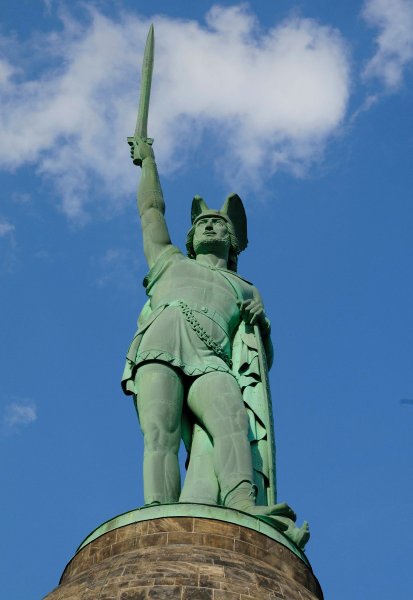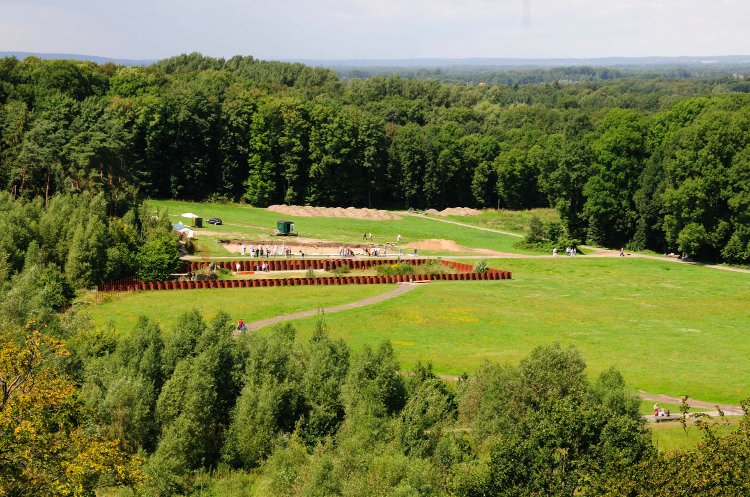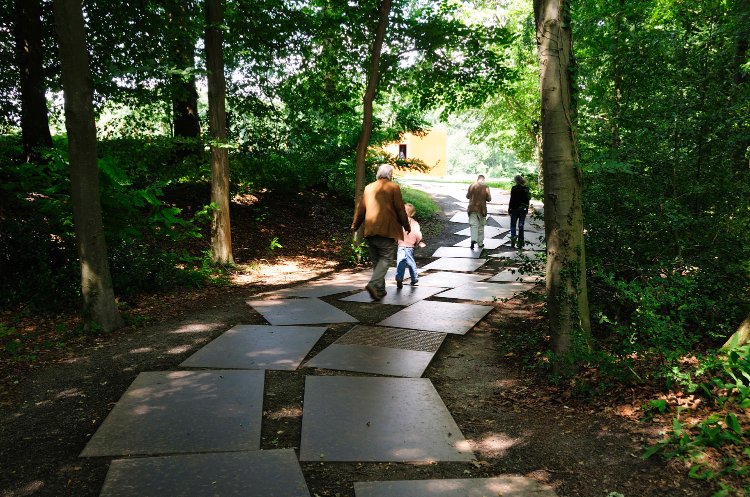
Germany's 20th century history has been so troubled that anniversaries of positive events are in short supply. This year has two such rare examples, the 20th anniversary of the fall of the Berlin Wall and the 60th of the establishment of democracy after World War II.
There's a third one coming up in September that represents nothing less than the birth of the German nation -- the 2,000th anniversary of a devastating victory over three Roman legions by Germanic tribes in the Battle of the Teutoburg Forest.
The battle created the first German hero, Arminius, or Hermann as he later became known, a young chieftain of the Cherusci tribe who led the rebellion and was hailed for centuries as the man who united the Germans and drove the Romans out of Germania.
But Germany is marking the event with noticeable restraint. There's no sense of glory and no program of flag-waving festivals of the sort one would expect in other nations celebrating their creation.
In fact, a lot of Germans don't even know about Arminius. Many schools shunned his story after 1945 because he became contaminated by the militant nationalism that led to Hitler. Interest has gradually reawakened since the discovery of the presumed site of the battle in the late 1980s, and there has been intense media coverage of the man and the myth this year.
Cautious Celebration
Chancellor Angela Merkel visited the battlefield in a forest near the village of Kalkriese in May to open an exhibition on Germanic tribes there, and some 400 actors dressed as Romans or Germanic tribesmen gently re-enacted scenes from the battle there in June, with rubber-tipped spears. Most actors wanted to be Romans, and there was such a shortage of Germanic warriors that some hirsute hobby Vikings had to be recruited to make up the numbers.
"This anniversary year has gone very well because it has been free of nationalist emotion," Tillmann Bendikowski, author of a new book on the battle and the myth of Hermann, told Spiegel Online. "It has been dealt with far more soberly than one might have expected."
The story of Arminius is a lesson in how history can be invented and turned into propaganda. From the 16th century onwards, when an account of the battle by Roman historian Tacitus resurfaced in a German monastery, nationalists fashioned the Germanic leader into an icon to help them forge unity in the face of such perceived enemies as the Vatican, the French and the Jews.
Arminius and the Battle of the Teutoburg Forest, they said, marked the origin of the German nation. Hermann, as Martin Luther called him, was deemed the perfect symbol to give a nation fragmented into dozens of states the identity it lacked.

"The battle became the big bang of the German nation in terms of myth and legend. But in terms of real history, it was no such thing," said Bendikowski.
The more than 50 Germanic tribes of the ancient period were the forefathers of many European nations, not just the Germans. And Arminius by no means united them -- he persuaded five tribes to join him in battle, and he was killed by members of his own tribe a few years later.
However, there's little doubt that the Battle of the Teutoburg Forest sent shockwaves through the Roman Empire. It was one reason why Rome abandoned plans to turn Germania east of the Rhine into a province.
Some 10,000 to 12,000 highly trained and battle-hardened legionnaires are believed to have been slaughtered at Kalkriese in an ambush orchestrated by Arminius. Three Roman legions were wiped out in four days of fighting on the narrow forest paths a few miles from what is now the city of Osnabrück. The entire Roman Empire stretching from northern England to Egypt only had 28 legions at the time.
The popular notion that Arminius drove the Romans out of Germania east of the Rhine is a fallacy, though. Roman legions were back in force six years after the battle, wreaking havoc and winning major battles. The discovery last year of an ancient battlefield some 100 kilometers east of Kalkriese, near the town of Kalefeld south of Hanover, testifies to Roman military presence deep in hostile Germania as late as the third century AD.
"It's typically German to say world history was shaped on German soil," said Bendikowski. "We know that this was one battle among many and that there was a range of factors behind Rome's eventual retreat to the Rhine. Everyone who needed this myth regarded it as the turning point of history. For many it remains the turning point. But it wasn't."
The Man and the Myth
The playwrights, writers and political leaders of the 18th and 19th centuries didn't let the facts get in the way of a good story. They were helped by a severe shortage of facts because the ancient Germanic tribes had no written culture and no Roman eyewitnesses survived the slaughter.
Hermann, portrayed as a blond, muscle-bound warrior, featured in more than 50 operas and plays during the 18th and 19th centuries, such as "The Battle of the Teutoburg Forest" written by German poet Heinrich von Kleist in 1808 as a call to arms against Napoleon's occupation. The figure came to epitomize the power of a young nation striving to be united and free.
The cult of Hermann continued to grow during the 19th century and was evoked impressively by a gigantic monument to him erected near the northwestern town of Detmold. Completed in 1875, four years after Germany unified, the statue wields a seven-meter (23 foot) sword and stares defiantly westwards -- towards France.
The statue became a focal point for a brand of nationalism that turned increasingly aggressive and racist and culminated in the Nazi quest to subjugate Europe and eradicate the Jews.
Hermann has never recovered. "I personally think this Hermann myth will pale. And I hope people in the future will take a closer look at history, question what they have learned and review the sources," Gisela Söger of the Kalkriese battlefield museum, told Spiegel Online. "We want to contribute to a spirit of taking a more sober, distanced look at history here."
Crushed Skulls and Slingshots
The Kalkriese museum displays spear tips, human bones with terrible battle wounds and metal parts from Roman body armor found on the battlefield in the more than 20 years since a British hobby archaeologist, Major Tony Clunn who was stationed in Germany with the British army, discovered 150 silver coins and three Roman slingshots about a kilometer from the site.
Traces of fighting have been found in a wide area around Kalkriese, which ties in with accounts by Roman historians that the battle lasted four days and began with ambushes on the thin column of legionnaires and supplies that stretched 15 kilometers along narrow forest paths.
The army was commanded by Publius Quinctilius Varus, a Roman general, and was heading south to spend the winter in a base by the Rhine.
Arminius, who belonged to the tribe of the Cherusci, was the commander of a troop of Germanic cavalry attached to the Roman army as auxiliaries. He led Varus into a trap by persuading him to make a detour to put down a rebellion, Roman historians wrote.
Varus trusted Arminius -- the two had dined together -- and agreed to change course. Then the Germanic warrior, who wanted to head a revolt that would help him found his own kingdom, rode off with his men to join up with fighters from other tribes hiding in the forests. They started a wave of guerrilla-style ambushes up and down the snaking column.
Romans Outwitted

After days of attacks, the battle is believed to have culminated at Kalkriese, a bottleneck between a hill and a moor where the Germans had erected an earthen wall from which to assault the Roman flank. Seeing that defeat was inevitable, Varus fell on his sword rather than be captured by the Germanic hordes slaughtering his troops all around him.
The site of the battlefield had been a mystery ever since the Hermann cult got going in the 16th century, and countless locations have laid claim to it. Some historians still have their doubts about Kalkriese, but they are now in the minority because the certainty that this is the true battlefield has grown steadily over the last two decades.
Eight pits containing the bones of men aged 20 to 45 have been found, with many skulls showing gaping holes from fatal blows. The pits tally with Roman accounts of how an army under commander Germanicus discovered the battlefield in AD16 and buried the heaps of bleached bones strewn across it. The soldiers also found skulls nailed to trees.
There are other clear indications that the battle was fought here. None of the 1,600 coins found were minted after AD9. Skeletons of mules were found -- only Roman armies used mules.
Tiny Metal Parts Tell Chilling Story
Other finds at Kalkriese tally with the presence of a Roman military column that wasn't expecting trouble. Ornate tableware, large amounts of cash, even a miniscule painted glass eye taken from a decorative figure that adorned a luxurious Roman dining sofa -- it's not exactly the equipment a Roman army would carry into battle. The army of Varus was moving home for the winter rather than embarking on a military campaign.
The most visually striking find is an iron face mask from a Roman cavalryman's helmet. But it's the myriad of unspectacular bits of metal that really tell the chilling story of the Battle of the Teutoburg Forest.
"We have been finding traces of plundering rather than of fighting," Susanne Wilbers-Rost, the chief archaeologist at the site, told Spiegel Online. "The excavations have revealed many small items torn off when the Germans were stripping the Romans as they lay dead or wounded. Things like buckles, hinges, connecting parts of body armor and chain mail.
"You can only imagine this kind of brutal stripping of the dead when the defeat was total, when no Romans survived," she said. "We know that the Romans always tried to retrieve their dead. The Germans had all the time in the world. They weren't disturbed."
Hermann on the Wane
Wilbers-Rost and her colleagues have even found evidence of organized sorting of equipment such as heavy Roman shields that the Germanic warriors had little use for. "They were mainly interested in the metal frames of the shields which they could melt down. We found many frames bent and folded ready to transport. That kind of folding can't have happened in battle."
Wilbers-Rost has gained international recognition for her work which has provided insights that can be applied to other battlefields of all ages. "This is a highly interesting excavation because it's very unusual to find an ancient battlefield. The locations of these sites usually aren't known because they were always plundered. Here we have found out that inconspicuous items can be indications of battle, or of related actions like plundering."
"Usually if you're looking for the remains of thousands of Romans and their enemies you wouldn't pay any attention to a few spear tips and a few remains of a few metal frames, but that may be an indication of a battle," said Wilbers-Rost.
Each year some 100,000 people visit the Kalkriese museum, which does a good job of explaining the battle. This year, visitor numbers are likely to be well above the average. The museum shop is doing a brisk trade in souvenirs such as "Hard Hermann" sausages, replica Germanic drinking horns and "Varus Temptation Waffles."
But the myth of Hermann has lost its power in modern Germany. The old nationalism has been replaced by an easy-going patriotism that mainly manifests itself at sporting events like the soccer World Cup. Today's interest in Arminius mainly reflects curiosity about what really happened in that fateful September 2,000 years ago. "This is a historical thriller," said Söger.
"The myth of Hermann will continue to wane," said Bendikowski. "What will remain of him will be the experience of how a historical myth was created, and how a nation sought to invent itself by fabricating history. It may help us to understand ourselves and other nations better."



Reader Comments
to our Newsletter